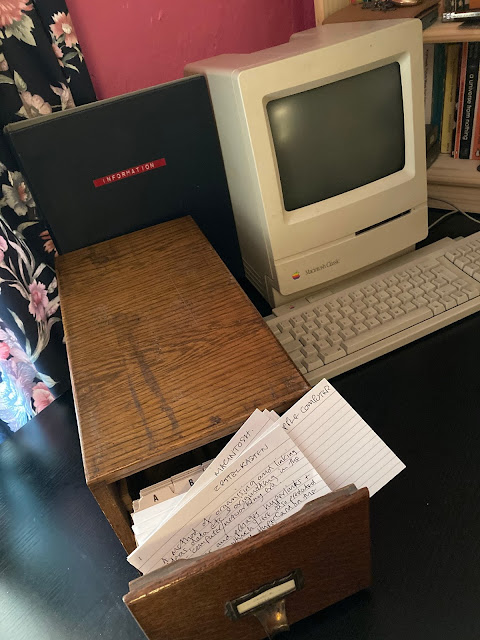Zettelkasten
 |
| Zettelkasten and Macintosh |
I'm guessing that a basic understanding of how the World Wide Web originated and its underlying organisational structure is only really held by people of a certain age and background - indeed just knowing the thing by its name - most people these days 'have the Internet' in much the same way that they have electricity or the telly.
Aside from the myriad complexities of how the internet itself and its subset, the World Wide Web actually function, let alone the details of the twenty-odd layers of software protocols involved; there is a single, unifying motive underlying the original concept dreamt up by Tim Berners-Lee at CERN in 1989 to enable the sharing and linking of documents between academics using the then Internet, as I've posted previously, a direct offshoot of the original packet-switched wide area network, ARPANET. The feature that made the Web different was its use of the Hyperlink: Hypertext; something no-one using the net these days is probably even aware of when they surf YouTube, FaceBook, etc. Everything you click to go somewhere else, look at a picture or watch a movie, is accessed via Hyperlinks.
That the protocol underlying its function and even the knowledge of its actual existence is now hidden under the web's ubiquity of utility is testimony not only to the efforts of the standards committees that oversee the way the web works, but to the overwhelming commercialisation and commodification of the web over the course of its still relatively short span of existence. Don't forget that the web as we know it didn't start to take over from the original academics-and-geeks playground until less than twenty-five years ago. Early adopters like us didn't even have search engines to find stuff.
The idea of linking data electronically was not novel in itself by the time of the web's inception: databases do this routinely as their allotted raison d'être. What marks hypertext and hyperlinking out from the crowd is the concept of linking documents together from within the body copy of the actual documents themselves. The credit for this concept, though has to go to the inventor of HyperCard; Bill Atkinson, who worked at Apple on the Lisa and Macintosh in the early/mid 1980's. He came up with the idea of a virtual card-index, with 'stacks' of 'cards', each of which could contain text, images and later other media. The crucial thing was that you could link things together, within a card, from card to card in a stack, or between different stacks, forming a hierarchy-free, random access way of navigating data and resources. Atkinson's only regret is that he didn't exploit the networking potential of the idea, which Berners-Lee later turned into the 'internet' we substantially recognise today.
Which brings me full circle to the point of this post: Zettelkasten, German for slip-box [plural Zettelkästen]: card-indexes of linked ideas, facts, data: stuff. Originally developed to catalogue libraries in the sixteenth century the Zettelkasten Method was adopted in the 1950's by Niklas Luhmann, who used it not only as his research and writing tool but as the theoretical underpinning of that research into systems theory. Pretty meta, I have to say. The thing about Luhmann and the Zettelkasten is that its underlying principle is that of the hyperlink, predating and prefiguring the World Wide Web by decades - not bad for an idea with its origins in the sixteenth century.
To my shame, I only discovered Zettelkasten this week, through you guessed it, surfing the internet. I've decided to give the technique a go - the card index version, that is; in keeping with my desire to preserve some of the analogue world in advance of the next global catastrophe that threatens to turn off the flow of electrons that we are all so utterly dependent on. I'll see how I get on anyway, and post back if it seems to be working for me, or not, as the case may be.
The photograph at the head of this piece comprises two thirds of the circle: a Mac and my nascent Zettelkasten. That this article is posted and disseminated via the web completes that circle.



I HATE to be pickey and a pain mate but you'll have to get on top of your filing: Zettlekasten goes in the "Z" (or Zees as our cousins would say!:) section and Macintosh in the the "M" section!!
ReplyDeleteJoe (The Great Pick in a Snoring Caravan overlooking a Silver Sea).
Thanks Kel not only for your blog but a simple but VV powerful (I hope) technique that I've just found: as you kno I'm dilsexic and use dictionaries all the time to correct what I can see is wrong but am not sure of why the spelling is wrong. Now I spelt Zettelkasten as Zettelcasten, normally I highlight the word that I'm not sure of and look it up then highlight the correct dictionary spelling and paste it OVER the one from my text. NOT NOW: I paste it NEXT to my original so that I can SEE what I'm doing wrong. I can't SEE, in my mind's eye, the fault but I CAN when they're next to each other! Will this herald less dictionary visits; only time will tell!!
BTW When we posited The axis of Buffoonery we both fell about laughing at its being the "piniclepinnicle of the absurd"!!! I've left my workings in for Sir to see that I now know about the bleedin' structure of crab grass!!!